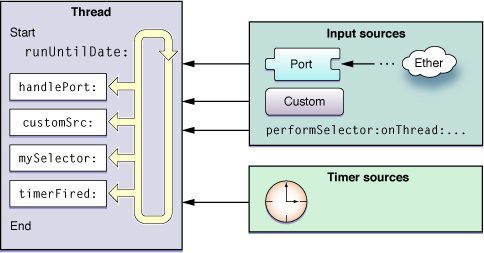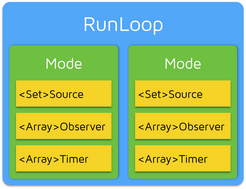iOS - RunLoop & AutoreleasePool
RunLoop
A NSRunLoop object processes input for sources such as mouse and keyboard events from the window system, NSPort objects, and NSConnection objects. A NSRunLoop object also processes NSTimer events.
RunLoop 的概念
运行循环也叫消息循环,作用是循环的捕捉消息,然后执行消息对应的操作;并且保证应用程序不会退出。
OSX/iOS 系统中,提供了两个这样的对象:NSRunLoop 和 CFRunLoopRef。CFRunLoopRef 是在 CoreFoundation 框架内的,它提供了纯 C 函数的 API,所有这些 API 都是线程安全的。NSRunLoop 是基于 CFRunLoopRef 的封装,提供了面向对象的 API,但是这些 API 不是线程安全的。
Input source 与 Timer source
Input source 与 Timer source这两个都是 RunLoop 事件的来源
Input Source 可以分为三类
- Port-Based Sources:系统底层的 Port 事件源,例如
CFSocketRef,但在应用层中几乎用不到。 - Custom Input Sources:用户手动创建的事件源,例如手势,触摸,键入。
- Cocoa Perform Selector Sources:Cocoa 提供的
performSelector系列方法也是一种事件源。
Timer Source
即是指定时器事件(NSTimer)。
RunLoop 与线程
线程和 RunLoop 之间是一一对应的,其关系是保存在一个全局的 Dictionary 里。线程刚创建时候并没有 RunLoop,如果你不主动获取,那么它一直不会有。RunLoop 的创建是发生在第一次获取时,RunLoop 的销毁是发生在线程结束时。所以只能在一个线程的内部获取 RunLoop(主线程除外)。
下图中展现了 RunLoop 在线程中的作用:从 input source 和 timer source 接受事件,然后在线程中处理事件。
Warning
The NSRunLoop class is generally not considered to be thread-safe and its methods should only be called within the context of the current thread. You should never try to call the methods of an NSRunLoop object running in a different thread, as doing so might cause unexpected results.
RunLoop Observer
RunLoop 通过监听 Source 来决定有没有任务要做;除此之外,我们还可以用 RunLoop Observer 来监控 RunLoop 本身的状态。
RunLoop Observer 可以监听以下 RunLoop 事件:
- The entrance to the run loop.
- When the run loop is about to process a timer.
- When the run loop is about to process an input source.
- When the run loop is about to go to sleep.
- When the run loop has woken up, but before it has processed the event that woke it up.
- The exit from the run loop.
RunLoop Mode
在监听与被监听中,RunLoop 要处理的事情非常复杂;为了让 RunLoop专注于处理特定事件而引入了 RunLoop Mode 概念
如果所示,RunLoop Mode 实际上是 Source、Timer、Observer 的集合,不同的 Mode 把不同组的 Source、Timer、Observer 隔绝开来;而 RunLoop 在某个时刻下只能跑在某一个 Mode 下,处理这一个 Mode 当中的Source、Timer 和 Observer。
苹果文档中提到的 Mode 有五个,分别是:
NSDefaultRunLoopModeNSConnectionReplyModeNSModalPanelRunLoopModeNSTrackingRunLoopModeNSRunLoopCommonModes
iOS 中公开暴露出来的只有 NSDefaultRunLoopMode 、UITrackingRunLoopMode 和 NSRunLoopCommonModes。 而NSRunLoopCommonModes 实际上是一个 Mode 的集合,默认包括 NSDefaultRunLoopMode 和 NSTrackingRunLoopMode。
RunLoop 的使用
RunLoop 和线程是绑定在一起的;每个线程(包括主线程)都有一个对应的 RunLoop 对象。
获取 RunLoop
我们不能自己创建 RunLoop 对象,只能获取到系统提供的 RunLoop 对象。
[NSRunLoop currentRunLoop]; |
在主线程和子线程中区别
RunLoop 在主线程和子线程中的 区别 在于:主线程的 RunLoop 会在应用启动的时候默认开启;其他线程(子线程)的 RunLoop 默认并不会启动,需要手动开启。
//手动启动RunLoop,无法控制结束 |
RunLoop 与 NSTimer
timerWithTimeInterval:
//需要手动加入 RunLoop 并设置 Mode |
scheduledTimerWithTimeInterval:
//默认加入 RunLoop 并设置 Mode 为 NSDefaultRunLoopMode |
坑
日常开发中,与 RunLoop 接触得最近可能就是通过 NSTimer,一个 Timer 一次只能加入到一个 RunLoop 中。我们日常使用的时候,通常就是加入到当前的 RunLoop 的 NSDefaultRunLoopMode 中,而 ScrollView 在用户滑动时,主线程 RunLoop 会转到 UITrackingRunLoopMode;而这个时候, Timer 就不会运行。
解决方案:
设置RunLoop Mode,例如 NSTimer,我们指定它运行于 NSRunLoopCommonModes ,这是一个Mode的集合。这样无论当前 RunLoop 运行哪个 Mode ,事件都能得到执行。
例如在 AFNetworking 中,就有相关的代码,如下:
- (void)startActivationDelayTimer { |
这里就是添加了一个计时器,由于指定了 NSRunLoopCommonModes,所以不管 RunLoop 处于什么状态,都会执行这个计时器任务。
Runloop 和 Autoreleasepool 的关系图解

Autorelease Pool
Autorelase Pool 提供了一种可以允许你向一个对象延迟发送 release 消息的机制;当你想放弃对象的所有权,同时又不希望这个对象被立即释放掉(例如在一个方法中返回一个对象时),Autoreleasepool就可以发挥作用。所谓的延迟发送release消息是指,当我们把一个对象标记为autorelease时:
NSString* str = [[[NSString alloc] initWithString:@"hello"] autorelease]; |
这个对象的retainCount+1,但不会发生 release;当这个变量所处的autoreleasepool被 倾倒(drain) 操作时,所有标记了autorelease的对象的 retainCount-1;即release消息的发送被延迟到autoreleasepool释放的时候了。
在 ARC 环境下,苹果引入了 @autoreleasepool 语法,不在需要手动调用autorelease 和 drain 等方法。
提示 : 此处讨论的自动释放池不是手动创建的,是跟运行循环相关的,并非
main.m中的@autoreleasepool
Autorelease Pool 的用处
在 ARC 下我们并不需要手动调用autorelease有关的方法,甚至可以完全不知道 autorelease 的存在,就可以正确的管理好内存;因为 Cocoa Touch 的 RunLoop 中,每个 RunLoop Circle中系统都加入了 Autorelease Pool 的创建和释放。
当我们需要创建和销毁大量对象时,使用手动创建的autoreleasepool可以有效的避免内存峰值的出现;因为如果不手动创建的话,外层系统创建的 Pool 会在整个 Runloop Circle 结束之后才执行 drain 操作,手动创建的话会在 block 结束之后就就执行 drain 操作。详情请见苹果官方文档
一个普遍被使用的例子如下:
for (int i = 0; i < 10000000; i++) |
在上面的例子中如果不使用autoreleasepool,需要在循环结束之后释放1000000个字符串;如果使用的话会在每次循环结束的时候都进行release操作。
Autorelease Pool 进行 Drain 的时机
如上所述,系统在 RunLoop 中创建的 autoreleasepool 会在 RunLoop 的一个 Event 结束时进行 Drain 操作;而我们手动创建的 autoreleasepool 会在 block 执行完后进行 Drain 操作。
但需要注意的是:
- 当 block 以异常(exception)结束时,pool 不会进行 drain 操作
- Pool 的 drain 操作会把所有标记为 autorelease 的对象
retainCount-1,但并不意味着这个对象一定会被释放掉;我们可以在 autoreleasepool 中手动 retain 该对象,以延长它的声明周期(在MRC中)
main.m 中的 autoreleasepool 的解释
在 iOS 程序的 main.m 文件中有类似这样的语句:
int main(int argc, char * argv[]) { |
在面试中问到有关autorealeasepool的知识时,也多半会问一下,这里的 pool 有什么作用?能不能去掉之类…
根据苹果官方文档:UIApplicationMain函数是整个 app 的入口,用来创建 application对象(单例)和application delegate;尽管这个函数有返回值,但是却永远不会返回,当按下Home键时,app 只是切换到了后台状态。
由文档知道,UIApplication会自己创建一个 main runloop,大致可以得到下面的结论:
main.m中 UIApplicationMain 永远不会返回,只有在系统kill掉整个app时候,系统会把应用占用的全部内存释放出来。- 因为 UIApplicationMain 永远不会返回,所以这里的 autoreleasepool 就永远不会进入到drain阶段。
- 假设真的有变量进入了main.m 中的这个 Pool(而没有被更内层的 Pool 捕获),那么这些内存实际上就是被泄露的,这个autoreleasepool 等于把这种泄露情况进行了隐藏。
- UIApplication自己会创建 main runlooop,在 Cocoa 的 RunLoop 中实际上也是包含 autoreleasepool 的,因此main.m中的autoreleasepool可以认为是 没有必要 的。
另外,在基于 AppKit 框架的 Mac OS 开发中,main.m中就是不存在 autoreleasepool 的,这也进一步印证了上面的结论。不过因为不知道更底层的代码,加上苹果文档中不建议修改main.m 文件,所以我们也没有理由把它删掉。但是,删掉之后也不会影响 App 运行,用 Instruments 也没有发现内存泄露。
autoreleasepool的创建与销毁
- 创建 : 运行循环检测到事件并启动后,就会创建自动释放池
- 销毁 : 一次完整的运行循环结束之前,会被销毁
以上,autoreleasepool的创建与销毁都和运行循环(RunLoop)息息相关。
参考资料
https://hit-alibaba.github.io/interview/iOS/ObjC-Basic/RunLoop.html
https://blog.ibireme.com/2015/05/18/RunLoop/

